If you live in an older home or simply want to improve the energy efficiency of your entryway, insulating your wooden front door can be an innovative and cost-effective solution.
Insulation helps keep your home warm in the winter and cool in the summer, resulting in lower energy bills and more comfortable living space.
However, insulating a wooden front door requires a bit of know-how to get it right.
Besides giving your house its unique character, the front door also plays many other important roles.
Keeping insects out of your property keeps you safe from intruders and keeps your home insulated and protected from cold and noise.
You can improve the efficiency of your entry door by insuring it further with additional insulation if it has deficiencies in this area.
If your current door has inherent deficiencies, it may be possible to improve it further with additional insulation.
Why Insulate An Old Wood Front Door?
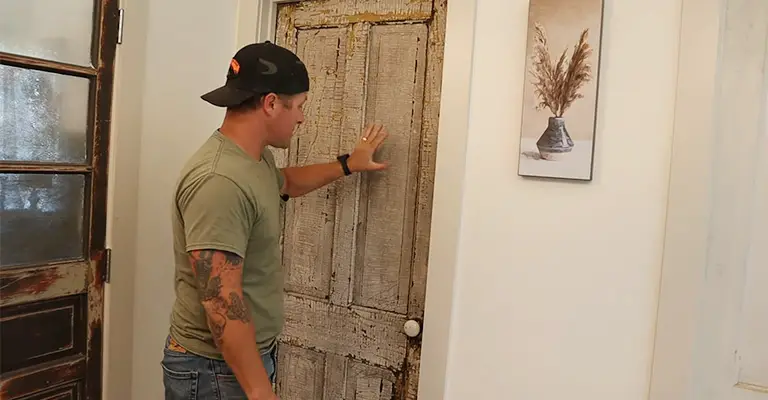
A wooden front door provides security for the house’s occupants. It protects them because of its solid construction. It is time. However, that is a wood door’s biggest enemy.
Doors made of wood can warp, causing air tightness issues and reducing insulation effectiveness.
Insuring your front door is beneficial in many ways, especially if it is done correctly. If your doors and windows are not properly insulated, you can lose as much as 20% of the heat they receive.
Old front doors are often not airtight and have many gaps and openings. Humidity and drafts can build up in these openings. The room can become uncomfortable and unpleasant when cold air enters from outside.
Consequently, you must increase your electricity bill to keep your house warm. There are several ways to solve this problem, including insulation.
Insulation offers additional benefits as well as protecting your home from other issues. There is a danger of moisture and mold forming around the door frame when air enters the house.
The air can become unhealthy to breathe as a result. Moreover, these areas can also be infested with pests. Door and window insulation are therefore highly recommended.
Can You Insulate A Wooden Door?
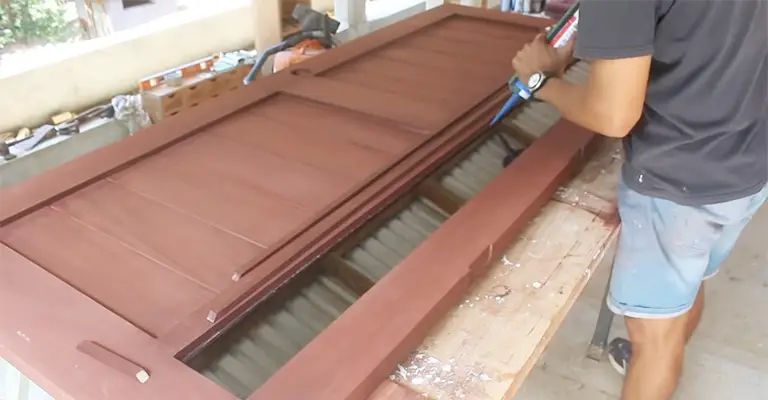
You can insulate wooden doors completely, and it is beneficial for the environment. The best way to insulate your house is to focus on your doors and windows, as these are the areas where heat quickly gains and losses.
Winters in a cooler climate can be harsh and cold. It is definitely worthwhile to think about insulating your front door.
By doing this, you can regulate your home’s temperature and make it more efficient in terms of energy usage.
The option of insulating the door yourself at home is an accessible and inexpensive one. A professional can perform the task for you if you wish.
You need to keep in mind that wood is a fragile material that can degrade under conditions such as moisture. In order to prevent moisture damage to your wooden door, make sure you treat it before you insulate it.
How Do You Insulate A Wooden Door?
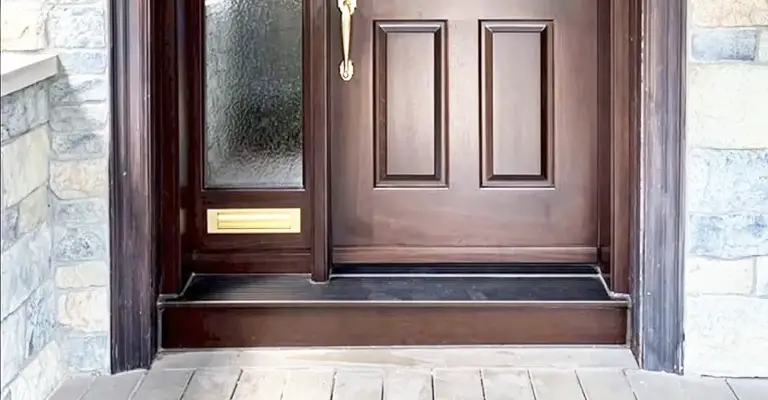
Almost all of today’s wood entry doors are treated with waterproof insecticides and fungicides. As a result, the door’s wood has been treated to prevent deterioration, insects, mold, and moisture from getting inside.
However, even with these treatments, inspecting your exterior wooden doors every year for any signs of water leaks or infiltration is imperative.
This door’s exterior wood has likely warped, and its seal no longer provides total airtightness.
To insulate your exterior wood doors, check the weatherstripping to see if water is coming through, and if so, replace it or apply a caulking product.
You can easily insulate your wooden front door with a combination of air sealing and direct insulation. To accomplish this, you can take a variety of steps, such as:
1. Improve Weatherstripping
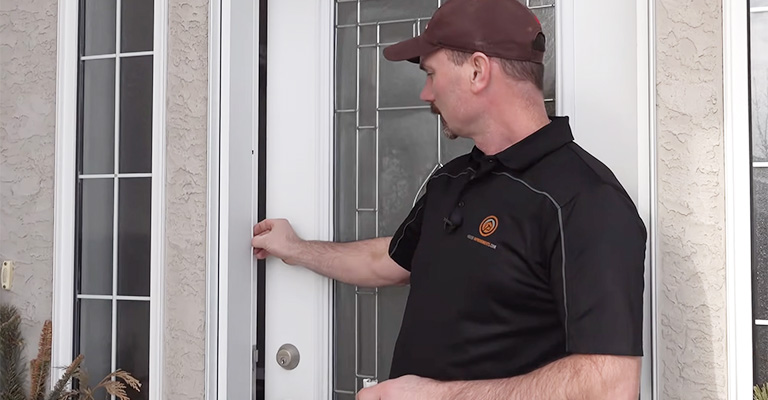
It is essential to weatherstrip your wood door when you want to insulate it. It is made of rubber or another pliable material that is rimmed around the edges of your door frames.
Most often, these materials become less effective over time or are not installed correctly. It is possible for weatherstripping to be damaged by pets, use, moving furniture, and ageing.
Moreover, your house’s weatherstripping, once sealed, your doors can loosen as it settles. You can usually tell if the weatherstripping around your door is damaged if it has tears, frayed areas, visibility, and feels.
In most cases, a home handyman can install new weatherstripping easily. A reasonable cost can be charged for hiring an expert to install this product for you. There is generally a $100 charge for weatherstripping one door.
How Do You Weatherstrip A Door?
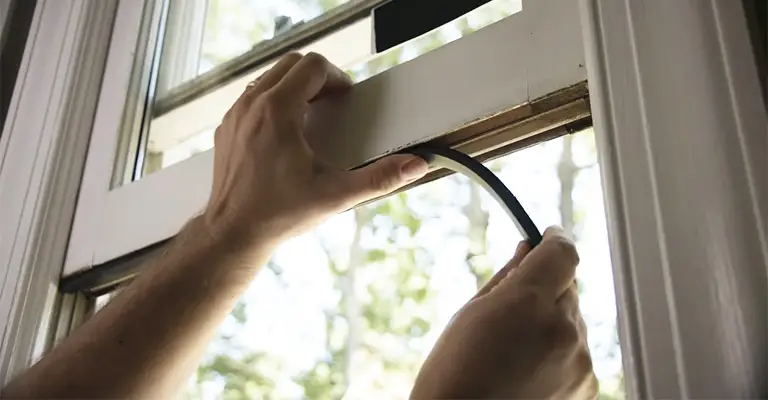
What type of weatherstripping you choose to use will determine how you weatherstrip a door. Whatever the style, however, removing old weatherstripping is the first step.
When you remove weatherstripping, it is commonly as simple as pulling it out of the built-in slots. However, you may need to use a drill to remove old weatherstripping.
In the next step, you need to mount your weatherstripping to the provided slot (or stick or screw it on). If you’d like the weatherstripping to fit tightly at the corners, you must cut one of the pieces at a 45-degree angle.
2. Install A Storm Door
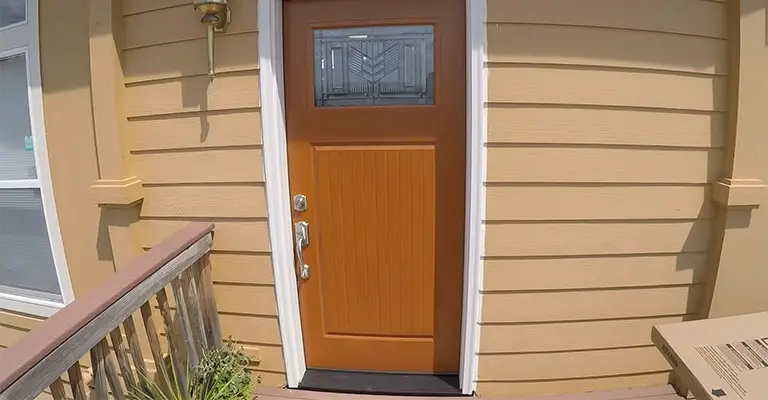
You can insulate your wooden front door by preventing any obstruction between the inside and outside.
Your storm door is essentially an extra door that opens outside instead of in, attached to the outside of your door frame.
If you plan to buy a storm door, make sure you measure the doorframe first. Storm doors that are purchased generally come with instructions and hardware required to install them.
Following the instructions included in the installation instructions is key to ensuring a successful installation once you have purchased the door.
The added bonus is that many storm doors come with matching season-appropriate inserts. For the winter, you can put solid or glass material in the door, and for the summer, a screen can be installed in the storm door.
3. Add Window Insulation
A wooden front door with a glass window insert can benefit from window insulation. Using this film material adds another layer of protection to help insulate your door window.
Ensure the material fits around the window before installing it. Lastly, follow the instructions on the film and attach it to your window frame. Depending on the window insulation, a hairdryer may work better to warm up the corner edges.
4. Caulk Cracks
You should caulk any cracks around your wooden door after insulating it. Specifically, you should caulk areas where air might be able to move inside from outside.
Rather than caulk your door closed, only caulk the cracks in the door frame and door trim, not between the door and frame. You should simply draw a line of caulk along the crack.
In time, you will become more adept at this process with practice. Use a caulk tool or your finger to smooth out the bead. If you plan to use a standard caulk tube, ensure you have a caulking gun.
5. Spray Foam Frame Gaps
This requires the most construction and home improvement knowledge of all these steps. Performing this step requires you to remove the door trim, also called casing, that protects the frame as it meets the wall.
By pulling carefully, you should not be able to damage the walls or cause the casing to break. It is important because you will need to replace the casing where you found it once you are done with it.
You don’t have to remove the casing externally – just remove the interior casing. You should pull casing nails with a nail puller, not pounding them out with a claw to pull them, as this will mark the trim’s clean face.
Once you remove the casing trim, you can check if there are any gaps around the door frames. Contractors often do not insulate these gaps. Canned spray foam is the easiest solution to fill this gap without insulation.
How To Use Canned Spray Foam?
Following the directions on the foam can carefully fill the gap between the door frame and the wall framing. Before working with this product, you should set something on the ground.
It can be extremely difficult to clean whenever spray foam comes into contact with anything. When you are learning about product expansion, spray a small amount of foam out of the nozzle at first.
Overfilling can cause a huge mess if you don’t follow directions correctly. When the foam has dried, use finish nails to reattach the trim as it was originally installed. As a result of this process, you may also be able to repurpose the old nail holes.
6. Improve Door Sweep
Basically, the door sweep is a piece of material that connects the bottom of the door to the bottom of the door jamb. A sweep is defined as something that sweeps across the ground as the door is opened and closed.
This material does not last forever and is susceptible to damage over time, like weatherstripping.
If you want to check your door sweep, get on your hands and knees and do it. The presence of fraying, incomplete rubber, and light are all signs that you need to replace your sweep.
You can purchase door sweeps that slide onto your doors or stick on, but these styles are not as long-lasting.
You should ensure that the new sweep fills the space underneath the door when purchasing one. In regards to this space, the construction and age of your home greatly influence its size.
How Do You Add A New Door Sweep?
The tricky part of adding some door sweeps is that you have to remove the door first. If you carefully remove the hinges and set the door on a work surface – the new sweep will be able to be attached.
Is Your Door Leaking Air?
You may suspect that some air is coming into your home, but it’s not clear which direction it’s coming from. Find out where the air leak is coming from by following these steps:
Using A Smoke Test
When performing the test, make sure combustion appliances are turned off. Also, make sure that all windows and doors are tightly closed. It is best to turn on the exhaust fan to remove all the air from the room in order to get accurate results.
You now need to place a lit incense stick or candle under the door. An air leak will be evident if smoke winds up in the room or gets sucked out.
Worn Out Caulk
In some cases, air can pass through when old caulk has peeled off. There will be cracks and gaps exposed as a result.
Ensure the caulk around the door frame is intact or worn away. Sealing the gaps again can be achieved with a new layer of caulk.
Look For Daylight
Whenever you are checking for air leaks, look for any spaces where light is coming from.
You should make the room as dark as possible by closing the windows and doors. Next, search for any spots where light is streaming through. There are also spaces where the air comes in.
What Is The U Factor For A Solid Wood Door?
A typical door is about 1-3/4 inches thick. Typical U-values for solid wood doors of this thickness are approximately 0.33.
Based on this, the R-value is 3.03. Solid wood doors perform much worse than most wall assemblies, ranging from R15 to R23.
Why Do Doors Swell In Winter?
There is more to door swelling than just swelling per se during the winter. The door shape also changes minutely during the cold season.
There is a difference between the relative humidity outside and inside (total humidity), so the outside relative humidity is lower than the inside relative humidity.
During the winter months, cold outside air can rarely hold moisture. However, warm indoor air can hold a large amount. It means the inside of the door will absorb more moisture than the outside.
As a result, the shape of the door is often altered, making closing and latching more challenging.
How Do You Stop A Wooden Door From Swelling?
The reduction of indoor humidity can prevent a wooden door from swelling and changing shape. It is possible to achieve this through the use of dehumidifying products.
What Makes A Door Energy Efficient?
In order for a door to be energy-efficient, both air and heat need to be prevented from moving from one side to the other.
This post outlines several steps that make your door more energy efficient – mainly by making it less likely that air can move between your door’s sides. An important factor that influences a door’s energy efficiency is the material of the door.
As an example, solid wood doors perform better at stopping heat transfer than hollow-core doors. Some doors are made of metal on the outside but with insulation inside.
Final Words
To keep cold drafts away, it’s important to make sure you insulate wooden doors properly. The risk of mold growth is greatly increased by any small gaps that let moisture pass through them.
Adding a thermal curtain to your wood entry door window may be an effective solution if the glass of your wooden entry door has a low insulation factor. It is helpful in combating low temperatures if the curtain has a thermal lining.
Cork is also an effective insulating material for doors, which can be added to the core of the door. You can enjoy a warmer, more comfortable home now that you know how to insulate a wooden front door.






